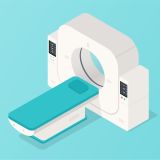An MRI technology degree program is a specialized educational program designed to train individuals to become MRI technologists. These programs typically result in an associate degree, although there are also bachelor’s degree programs available. Here is a detailed breakdown of what you can expect from an MRI technology degree program:
- Program Length: Most Associate Degree Programs in MRI Technology take around two years to complete, while bachelor’s degree programs may take four years. The program duration can vary depending on factors such as full-time or part-time enrollment and the specific curriculum structure.
- Prerequisite Requirements: To gain admission to an MRI technology degree program, you typically need a high school diploma or equivalent. Some programs may also require prerequisite coursework in subjects such as anatomy, physiology, physics, and mathematics.
Core Curriculum
MRI technology degree programs consist of a combination of didactic (classroom) instruction and hands-on clinical training. The core curriculum covers a range of topics essential for MRI technologists, including:
- MRI Physics and Instrumentation: Understanding the principles of magnetic resonance imaging, including the physics behind image formation and the operation of MRI equipment.
- Anatomy and Pathology: Studying the human anatomy and learning to recognize and interpret anatomical structures and abnormalities on MRI scans.
- Patient Care and Safety: Learning how to ensure patient comfort, safety, and proper positioning during MRI procedures. This includes addressing patient needs, managing emergencies, and implementing safety protocols related to the strong magnetic field of the MRI scanner.
- Image Acquisition and Analysis: Acquiring high-quality MRI images by selecting appropriate imaging protocols, adjusting imaging parameters, and optimizing image quality. Analyzing and interpreting MRI images to assist in diagnosis and treatment planning.
- Radiographic Procedures: Gaining proficiency in radiographic techniques, including patient preparation, contrast administration, and imaging procedures specific to MRI, such as magnetic resonance angiography (MRA) or functional MRI (fMRI).
Clinical Training
MRI technology programs typically include a clinical component that provides hands-on experience in a healthcare setting. Students are placed in MRI departments or imaging centers, where they work under the supervision of experienced technologists. This clinical training allows students to apply their knowledge and skills in real-world scenarios, interact with patients, and become proficient in operating MRI equipment.
Certification Preparation
Many MRI technology programs prepare students for the certification examination administered by the American Registry of Radiologic Technologists (ARRT). The curriculum is designed to cover the content areas tested on the exam, ensuring that students are well-prepared for certification upon graduation.
Accreditation
It is important to choose an MRI technology degree program that is accredited by a recognized accrediting body, such as the Joint Review Committee on Education in Radiologic Technology (JRCERT). Accreditation ensures that the program meets certain standards of quality and prepares students adequately for their future careers.
Upon successful completion of an MRI technology degree program, graduates are eligible to sit for the ARRT certification exam to become certified MRI technologists. This certification is often required by employers and regulatory bodies for employment in the field.

